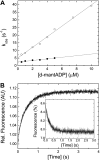Kinetic characterization of the sole nonmuscle myosin-2 from the model organism Drosophila melanogaster
- PMID: 25636739
- PMCID: PMC4396609
- DOI: 10.1096/fj.14-266742
Kinetic characterization of the sole nonmuscle myosin-2 from the model organism Drosophila melanogaster
Abstract
Nonmuscle myosin-2 is the primary enzyme complex powering contractility of the F-actin cytoskeleton in the model organism Drosophila. Despite myosin's essential function in fly development and homeostasis, its kinetic features remain elusive. The purpose of this in vitro study is a detailed steady-state and presteady-state kinetic characterization of the Drosophila nonmuscle myosin-2 motor domain. Kinetic features are a slow steady-state ATPase activity, high affinities for F-actin and ADP, and a low duty ratio. Comparative analysis of the overall enzymatic signatures across the nonmuscle myosin-2 complement from model organisms indicates that the Drosophila protein resembles nonmuscle myosin-2s from metazoa rather than protozoa, though modulatory aspects of myosin motor function are distinct. Drosophila nonmuscle myosin-2 is uniquely insensitive toward blebbistatin, a commonly used myosin-2 inhibitor. An in silico modeling approach together with kinetic studies indicate that the nonconsensus amino acid Met466 in the Drosophila nonmuscle myosin-2 active-site loop switch-2 acts as blebbistatin desensitizer. Introduction of the M466I mutation sensitized the protein for blebbistatin, resulting in a half-maximal inhibitory concentration of 36.3 ± 4.1 µM. Together, these data show that Drosophila nonmuscle myosin-2 is a bona fide molecular motor and establish an important link between switch-2 and blebbistatin sensitivity.
Keywords: actin; blebbistatin; cytoskeleton; rotamer; transient kinetics.
© FASEB.
Figures





Similar articles
-
Kinetic mechanism of blebbistatin inhibition of nonmuscle myosin IIb.Biochemistry. 2004 Nov 23;43(46):14832-9. doi: 10.1021/bi0490284. Biochemistry. 2004. PMID: 15544354
-
Specificity of blebbistatin, an inhibitor of myosin II.J Muscle Res Cell Motil. 2004;25(4-5):337-41. doi: 10.1007/s10974-004-6060-7. J Muscle Res Cell Motil. 2004. PMID: 15548862
-
Kinetic mechanism of Nicotiana tabacum myosin-11 defines a new type of a processive motor.FASEB J. 2015 Jan;29(1):81-94. doi: 10.1096/fj.14-254763. Epub 2014 Oct 17. FASEB J. 2015. PMID: 25326536
-
Mammalian nonmuscle myosin II comes in three flavors.Biochem Biophys Res Commun. 2018 Nov 25;506(2):394-402. doi: 10.1016/j.bbrc.2018.03.103. Epub 2018 Mar 17. Biochem Biophys Res Commun. 2018. PMID: 29550471 Free PMC article. Review.
-
The heavy chain has its day: regulation of myosin-II assembly.Bioarchitecture. 2013 Jul-Aug;3(4):77-85. doi: 10.4161/bioa.26133. Bioarchitecture. 2013. PMID: 24002531 Free PMC article. Review.
Cited by
-
Kinetic signatures of myosin-5B, the motor involved in microvillus inclusion disease.J Biol Chem. 2017 Nov 3;292(44):18372-18385. doi: 10.1074/jbc.M117.801456. Epub 2017 Sep 7. J Biol Chem. 2017. PMID: 28882893 Free PMC article.
-
Local pulsatile contractions are an intrinsic property of the myosin 2A motor in the cortical cytoskeleton of adherent cells.Mol Biol Cell. 2017 Jan 15;28(2):240-251. doi: 10.1091/mbc.E16-05-0335. Epub 2016 Nov 23. Mol Biol Cell. 2017. PMID: 27881665 Free PMC article.
-
Real-time insights into regulated exocytosis.J Cell Sci. 2017 Apr 15;130(8):1355-1363. doi: 10.1242/jcs.193425. Epub 2017 Mar 16. J Cell Sci. 2017. PMID: 28302911 Free PMC article. Review.
-
The mechanobiology of actin cytoskeletal proteins during cell-cell fusion.J R Soc Interface. 2019 Jul 26;16(156):20190022. doi: 10.1098/rsif.2019.0022. Epub 2019 Jul 24. J R Soc Interface. 2019. PMID: 31337301 Free PMC article.
-
Photorhabdus luminescens TccC3 Toxin Targets the Dynamic Population of F-Actin and Impairs Cell Cortex Integrity.Int J Mol Sci. 2022 Jun 24;23(13):7026. doi: 10.3390/ijms23137026. Int J Mol Sci. 2022. PMID: 35806028 Free PMC article.
References
-
- Young P. E., Richman A. M., Ketchum A. S., Kiehart D. P. (1993) Morphogenesis in Drosophila requires nonmuscle myosin heavy chain function. Genes Dev. 7, 29–41 - PubMed
-
- Sellers J. R. (2000) Myosins: a diverse superfamily. Biochim. Biophys. Acta 1496, 3–22 - PubMed
-
- Bloor J. W., Kiehart D. P. (2001) zipper Nonmuscle myosin-II functions downstream of PS2 integrin in Drosophila myogenesis and is necessary for myofibril formation. Dev. Biol. 239, 215–228 - PubMed
-
- Okumura T., Fujiwara H., Taniguchi K., Kuroda J., Nakazawa N., Nakamura M., Hatori R., Ishio A., Maeda R., Matsuno K. (2010) Left-right asymmetric morphogenesis of the anterior midgut depends on the activation of a non-muscle myosin II in Drosophila. Dev. Biol. 344, 693–706 - PubMed
Publication types
MeSH terms
Substances
Grants and funding
LinkOut - more resources
Full Text Sources
Other Literature Sources
Molecular Biology Databases

